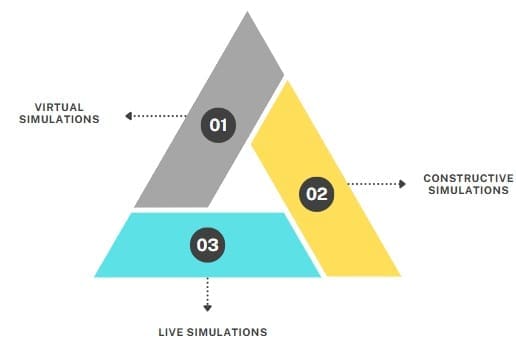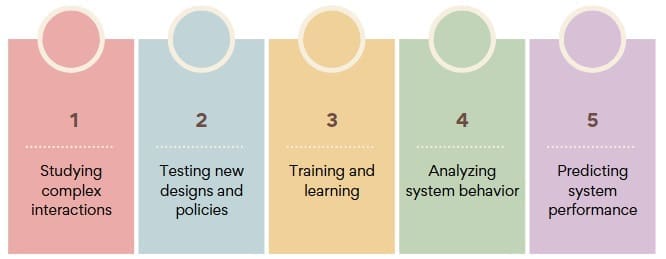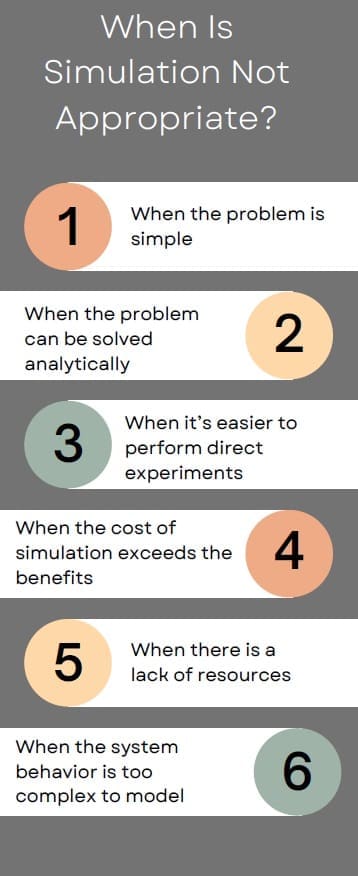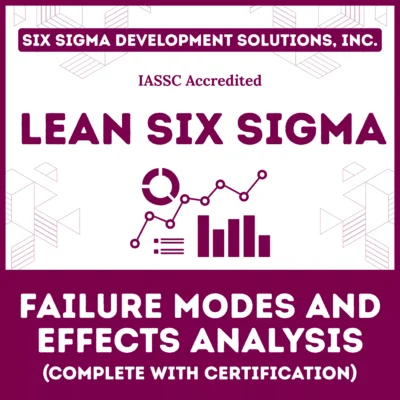Simulation is an important tool used to analyze and understand complex systems. In essence, it allows us to model real-world systems and test different strategies or actions in a controlled environment, helping to predict how the system might behave in reality.
In this guide, we’ll explore what simulation is, its key components, how it works, and how it’s used to address real-world challenges. The focus will be on discrete-event simulation, one of the most widely used types of simulation.
Table of contents
What is Simulation?
Simulation, as defined by Shannon (1975), is “the process of designing a model of a real system and conducting experiments with this model for the purpose either of understanding the behavior of the system or of evaluating various strategies for the operation of the system.”
Essentially, it involves creating a virtual model of a system and experimenting with different scenarios to see how the system behaves under varying conditions.
A discrete-event simulation (DES) is one of the most commonly used types of simulation. It focuses on systems where changes occur at distinct points in time, triggered by specific events.
For example, when a car drives up to a fast-food restaurant drive-through, that action could trigger a series of events that change the state of the system (e.g., customer orders food, food is prepared, customer picks up the order).
The power of simulation lies in its ability to replicate real-world dynamics. Traditional optimization models can handle certain aspects of system behavior, but they often fail to capture the dynamics or changes that occur over time.
Simulation, on the other hand, can model how systems evolve and help us understand those changes more thoroughly. This ability to simulate dynamic behavior is what makes discrete-event simulation particularly useful for analyzing systems in various industries.
Understanding Simulation Models
At its core, a simulation model is a conceptual framework that describes a real-world system. These models help in studying the behavior of systems that evolve over time. The construction of a simulation model requires a set of assumptions, which may be mathematical, logical, or symbolic in nature. These assumptions define how the various entities in the system interact with each other.
The key objective of simulation modeling is to study how systems behave under different conditions. This can be done by simulating various scenarios or testing different input parameters to predict the impact of changes.
A simulation model can answer questions like: What would happen if we change the supply chain process? or How will a new policy affect overall system performance?
Types

There are three primary classes of simulation:
- Virtual Simulations: These represent systems both physically and electronically, incorporating human interaction in a virtual environment. For instance, flight simulators for training pilots or virtual combat trainers used by the military are examples of virtual simulations. These systems simulate a real-world environment as closely as possible, providing immersive experiences. In advanced versions, virtual prototypes allow users to interact with computer-generated models, simulating the real system’s behavior.
- Constructive Simulations: These are computer-based simulations that represent a system’s structure or behavior, typically without human intervention. These include tools like computer-aided design (CAD), mockups, and computer models that help simulate different aspects of a system’s design and performance. Constructive simulations are vital during the system’s development phase, helping engineers analyze and refine design choices. Tools like CAD, computer-aided engineering (CAE), and computer-aided manufacturing (CAM) are part of this category and are widely used to design systems and analyze their feasibility and efficiency.
- Live Simulations: These involve real operators using real equipment in realistic environments. For example, military exercises, disaster recovery drills, and testing of new equipment in field conditions fall under this category. Live simulations are essential to validate and verify virtual and constructive simulations, but they tend to be costlier and are typically used when it’s crucial to mimic real-world conditions as accurately as possible.
Why Use Simulation?
Simulation models provide an effective way to analyze and predict the behavior of systems before making any changes in the real world. The advantage of using simulation is that it allows organizations to test various changes and understand their potential impact without the risk or cost of actual implementation.
Through simulation, we can evaluate different strategies, policies, designs, and even machine configurations to determine their effectiveness.
For example, in manufacturing, simulation can help businesses optimize their production process by simulating changes in machine speed, assembly line configuration, or supply chain processes.
In healthcare, it can model patient flow or resource allocation to improve service delivery. It is an excellent tool for answering “what if” questions, such as, What if demand for a product increases unexpectedly? or What if a machine breaks down in the middle of production?
When Is Simulation Appropriate?

It is a powerful tool, but it is not always the best solution for every problem. It is particularly useful when:
- Studying complex interactions: It allows for the study of how different subsystems interact within a larger system, which can be difficult to analyze analytically. For example, the operation of a factory or the flow of customers in a restaurant involves multiple variables and interactions that are best studied through simulation.
- Testing new designs and policies: Simulation models allow organizations to evaluate new policies, designs, or strategies before they are implemented in the real world. This can help identify potential issues and optimize performance without incurring real-world costs or disruptions.
- Training and learning: Simulation models are often used for training purposes, providing learners with hands-on experience in a controlled environment. For example, pilots use flight simulators to practice operating an aircraft before flying a real one.
- Analyzing system behavior: If the system being studied is too complex or involves numerous variables, simulation can provide valuable insights into how the system operates and where improvements can be made.
- Predicting system performance: It can predict the effects of changes to a system, such as altering resource allocation or introducing new equipment.
When Is Simulation Not Appropriate?

Despite its advantages, simulation is not always the best tool for every situation. There are several scenarios where simulation might not be the most effective approach when:
- The problem is simple: If the problem can be solved through common sense or basic calculations, simulation might be overkill. For example, determining the total cost of producing a certain number of units can be done using simple arithmetic.
- The problem can be solved analytically: If a problem can be solved using standard mathematical models or formulas, there may be no need for simulation. For example, simple inventory models or queuing models may be solvable through analytical techniques.
- It’s easier to perform direct experiments: If direct experimentation can provide the necessary results, running a simulation may not be worth the effort. In some cases, physical tests or experiments may be more efficient than building a simulation model.
- The cost of simulation exceeds the benefits: Developing a simulation model can be time-consuming and expensive. If the potential benefits of simulation do not outweigh the cost, it may not be worth pursuing.
- There is a lack of resources: It requires specialized software, computational resources, and trained personnel. If these resources are not available, simulation may not be feasible.
- The system behavior is too complex to model: Some systems, such as human behavior or social systems, may be so complex that it is difficult to model them accurately. In such cases, other methods of analysis may be more appropriate.
Advantages
It offers several advantages that make it a valuable tool in various fields:
Flexibility in testing scenarios: New policies, operating procedures, and designs can be explored without disrupting ongoing operations. For example, a new factory layout can be tested through simulation before being physically implemented.
Time manipulation: It allows for the compression or expansion of time, enabling the study of processes at different speeds. This can help identify potential bottlenecks or delays in a system.
In-depth analysis: Simulation models help identify key variables that influence system performance and reveal how different factors interact. This can lead to insights that are difficult to obtain through traditional analysis.
Risk-free experimentation: It allows for experimentation in a risk-free environment. Changes can be made to the system without worrying about the consequences in the real world.
Cost savings: It can help avoid costly mistakes by testing changes or new designs in a virtual environment before committing resources to them.
Disadvantages
While simulation has many advantages, it also has some limitations:
Model building requires special expertise: Developing accurate simulation models requires specialized knowledge in both the subject matter and simulation techniques. This can be a barrier for some organizations.
Interpretation of results can be challenging: The results of a simulation may not always be straightforward, and interpreting the behavior of the system can be complex.
Time-consuming and expensive: Building and analyzing simulation models can be time-consuming and expensive, particularly for large, complex systems.
Requires computational resources: Running large simulations requires significant computational power, which may not always be available.
How Does Simulation Work?
The simulation process works by simulating the passage of time and tracking the state of the system as it evolves. In a discrete-event simulation, the system progresses from one event to the next. Each event triggers changes in the system’s state, and the simulation moves from one state to another.
At each step, the simulation must make decisions about what happens next based on the current state of the system. This decision-making process is often governed by a set of rules or logic that reflects how the real system operates.
For example, in our drive-through example, the simulation must decide whether Fred can move forward in the line based on whether there is enough space.
The use of random number generation ensures that the simulation reflects the inherent uncertainty and variability found in real-world systems. By repeating the simulation many times (running multiple trials), we can observe the range of possible outcomes and use the results to make more informed decisions about how to improve the system.
Applications
It has a wide range of applications across various industries, including manufacturing, healthcare, logistics, finance, and more. Some common uses of simulation include:
- Process optimization: It helps identify bottlenecks or inefficiencies in a process and allows companies to test different strategies to improve performance without disrupting actual operations.
- Capacity planning: By simulating different scenarios, businesses can determine the optimal number of resources (e.g., workers, machines, etc.) required to meet demand.
- Risk analysis: It allows organizations to assess the risks associated with different strategies or actions and make more informed decisions.
- Customer service: In service industries like restaurants, simulation can help analyze customer flow, wait times, and service capacity to enhance customer experience.
Final Words
It is a powerful tool that can be used to analyze and improve complex systems. By modeling a system’s behavior, we can test different strategies, identify inefficiencies, and optimize performance. Discrete-event simulation, in particular, is valuable for modeling dynamic systems where changes occur at distinct points in time.
Understanding the structure and function of simulation is key to using it effectively in various industries, from manufacturing to healthcare to logistics.
However, successful simulation requires careful model design, data collection, and analysis to ensure that the results are accurate and meaningful.


















